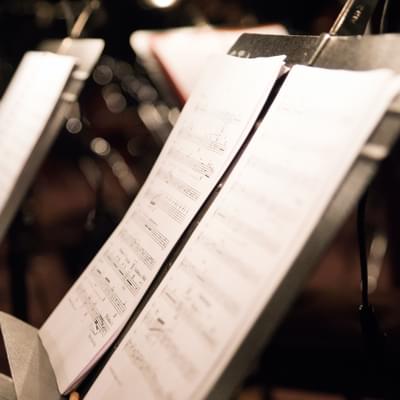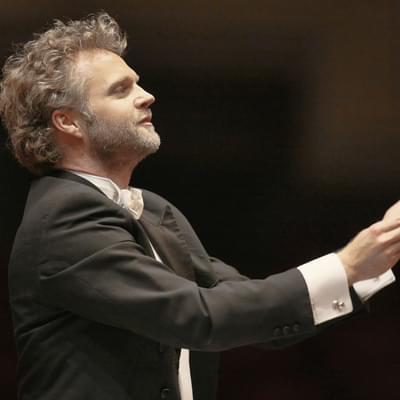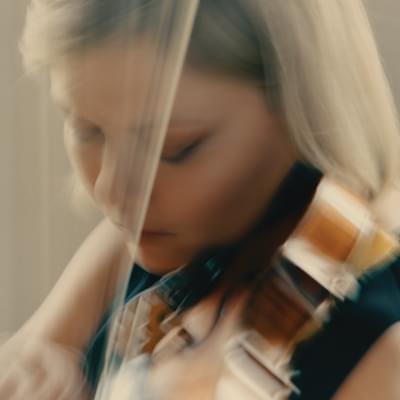Shostakovich 8
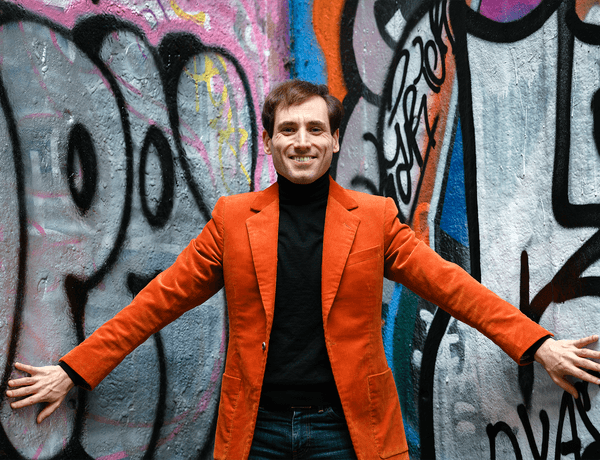
Full programme
- Rachmaninoff, Rhapsody on a Theme of Paganini (24mins)
- Shostakovich, Symphony No.8 (65mins)
Performers

Michael Seal
Conductor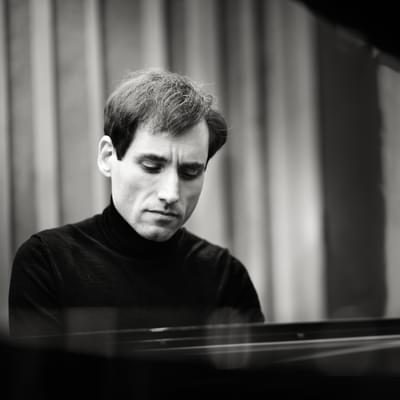
Boris Giltburg
Piano
Introduction
© Michael Seal, Associate Conductor
Tonight’s concert features two works written by two great Russian composers that, on first impression at least, couldn’t be more different from each other. What both pieces have in common is that they look both backwards and forwards.
Rachmaninoff’s Rhapsody on a Theme of Paganini is a set of variations based on the opening theme of Paganini’s 24th Caprice. It is easy to see how he is looking back - basing the whole piece on a theme written over a hundred years before, using a compositional format that had been around for centuries, and even quoting within the piece the Dies Irae, the ancient plainchant that Rachmaninoff seemed obsessed by.
The piece looks forward due to some of the technical challenges, so much so that Rachmaninoff himself was extremely nervous before the premiere about some of the passages he had written for himself! The premiere in 1934 was, however, a great success, and the work has been extremely popular ever since.
Just nine years later, the world was a very different place in the summer of 1943. One might have expected Shostakovich to have written a symphony that depicted the events of that year, most notably the German defeat at Stalingrad a few months earlier. One might argue that there are elements of the symphony that do that, but I think he is thinking much further back than that.
He is quoted as saying that his wartime symphonies were “requiems” for the Russian people. I think they are, but mostly for those who had perished in the pre-war years of terror under Stalin. The third movement, often described as depicting a warlike machine, could also be thought of as depicting the screams of those tortured under any brutal regime.
In a symphony that travels from C Minor to C major, one would expect a journey from darkness to light, but I do not hear that. What I hear is Shostakovich saying that we have survived the war, but at what cost. And when this war is over, what then?
Downloads List
Programme Notes
© Daniel Elphick
As the USSR faced the onslaught of Nazi Germany, Shostakovich poured his feelings into a symphony on a colossal scale. Shostakovich’s Eighth is music forged from blood, fire and steel – massive, uncompromising, and so powerful that after the war, they banned it. But first, true romance: as the fabulous Boris Giltburg plays Rachmaninoff’s glittering Rhapsody on a Theme of Paganini.
Rachmaninoff, Rhapsody on a Theme of Paganini
The finale of Nicolo Paganini’s 24 Caprices has inspired many composers to write variations on its self-contained 12-bar theme, including Brahms and Witold Lutosławski, though Russian composer Sergei Rachmaninoff’s 1934 Rhapsody on a Theme of Paganini is the most famous and for good reason. Rachmaninoff brings all his flair and pianistic virtuosity to the theme with a thrilling level of invention in how he presents variations and developments from Paganini’s original piece.
By 1934, Rachmaninoff had long lived outside of Russia having fled the Bolshevik revolution, and he split his time mostly between the United States and Switzerland, where he wrote the Rhapsody in a period of just six weeks during his summer break.
A long-standing myth of Rachmaninoff’s biography is the idea that he was virtually unable to write any music once he had left Russia, plunged into a nostalgia-induced depression for his homeland. Through tireless efforts of scholars, this myth is now considered inaccurate: if anything, it was Rachmaninoff’s incredible success as a concert pianist that limited his ability to compose, with a packed performing schedule. Nowhere is his performing prowess more clearly demonstrated than in the stunning displays in the Rhapsody. The piece is an impressive vehicle for piano soloist and in this way is very close to being a piano concerto, though not in name (the Rhapsody is also shorter than Rachmaninoff’s other piano concertos, and it is only a single movement). Rachmaninoff himself was soloist during the first performances of the work and there are several fine recordings of him playing it.
There are 24 variations in total, presented in an uneven structure even from the very beginning, with the presentation of a variation before the theme. The variations are grouped into three sections: 1-10 form the first section and presents easily the most acrobatic and nimble piano writing of the piece, with surging and competitive writing for the accompanying orchestra. The second section of variations 11-18 begins to move away from the stormy first section to develop more tender and plaintive themes; the 18th variation is frequently excerpted as a stand-alone piece in its own right. Through a clever inversion of the theme (effectively turning it upside down), Rachmaninoff creates a warm, yearning variation, made even more bright through the key of D-flat major (that is, far removed from the original key of A minor).
Variations 19-24 serve as a short but impressive finale, as the orchestra leads the charge towards the conclusion. Increasingly, Rachmaninoff uses a countermelody called the Dies Irae chant (commonly associated with death, owing to its presence in the requiem mass). This provides a weighty counterpoint to the sprightly melody, in terms of sound and also signification, though the piece does not finish on a dour tone: Rachmaninoff has the last laugh, as the Rhapsody finishes with just a handful of short notes to conclude – a far cry from the pianistic fireworks that we might have come to expect by the end of such a dazzling piece.
Shostakovich, Symphony No.8
Dmitri Shostakovich’s Seventh Symphony, written as a representation of the Nazi invasion into the Soviet Union in 1941, propelled him to world fame: he was even featured on the cover of ‘Time’ magazine. This success placed Shostakovich under considerable pressure to create a followup. He began to write his Eighth Symphony still during the Second World War in 1943, which set expectations for its character: that it should be optimistic and inspire the Soviet people and wider Allied forces towards victory. Instead, Shostakovich wrote a tragic and pain-filled piece that stopped short of a fully positive conclusion. By 1943, the Soviet people had suffered tremendous casualties during the war, and this brought a growing acceptance of depictions of suffering and pain in Soviet art (which had previously been forbidden by the state). The trouble for Shostakovich was that his Eighth Symphony engaged with these emotions wholeheartedly, but it was finished just in time for the tide of war to change in the Soviets’ favour, so the spirit of victory was expected. As a result, Soviet critics gave it a lukewarm reception, rather than outright celebration or rejection. Shostakovich wrote that the Symphony ‘contains many inner conflicts, both tragic and dramatic […] but, on the whole, it is an optimistic, life-affirming work’. It is difficult even today for audiences to accept this supposedly optimistic narrative.
The first movement is by far the longest, beginning with a dour theme in the low strings before a contrasting melody from the violins. This is followed by a long and
complicated ‘development’, whereby the composer executes a variety of technical means to adapt and contrast the themes that we have already heard. There then begins a slow and extended and poignant dialogue between these two melodies, each taking turns to expand and then contract, but Shostakovich punctures the mood entirely with military-like motifs that make the previously tender themes suddenly brutal: it is easy to listen and imagine the horrors of war.
Two quick march-like movements follow, both of them continuing the imagery of violence but even more exaggerated. The expanded orchestra is deployed to the fullest in the second movement, with explosive energy performed by instruments overlapping and doubling up their notes to emphasise uncomfortable clashes as much as possible. The third movement focuses on crude scream-like sounds in the woodwinds which contrast with military-like snare drums and bugle calls.
The fourth movement dissolves this grotesque imagery with a grim sense of stillness, interupted by string-plucked 'pizzicato' notes and the clarinet playing a sprightly line dancing between the strings. The fifth and final movement opens with Shostakovich in his ‘pastoral’ mode, including a strangely light-hearted bassoon
solo and broad string melodies – only to be interrupted again with the violence of military marches, drums, and bugle calls. This, however, dissolves into a recollection of the fourth movement, with more solo lines. The lack of a clear overarching structure now begs the question: how to end the piece? Shostakovich’s solution was to change key into C major at the start of the final movement (the major version of the minor key that the Symphony began with, itself a traditional device harking back to Beethoven) – but something about these C major chords doesn’t sound comfortable. Years later, a close friend praised this ending shift to a major tonality; Shostakovich replied: ‘My dear friend, if you only knew how much blood that C major cost me’. With these final chords, the symphony ends leaving the sense of questions unaddressed and difficult images left to linger in the listener’s mind.
Despite all its dramatic imagery, the Eighth Symphony never enjoyed the success of the Seventh during Shostakovich’s lifetime. After the war, the Eighth was heavily criticised and it was effectively banned from performance starting from 1948 (only to be rehabilitated in 1956). Shostakovich wrote ‘I can sum up the philosophical conception of my new work in three words: life is beautiful. Everything that is dark and gloomy will rot away, vanish, and the beautiful will triumph’. Today it is widely celebrated as one of his best works, though it can sometimes be a difficult listen that raises more questions than it answers.
Daniel Elphick is a lecturer in Musicology at Royal Holloway, University of London, specialising in Russian and East-European Music since 1800. His book Music Behind the Iron Curtain is available from Cambridge University Press.
